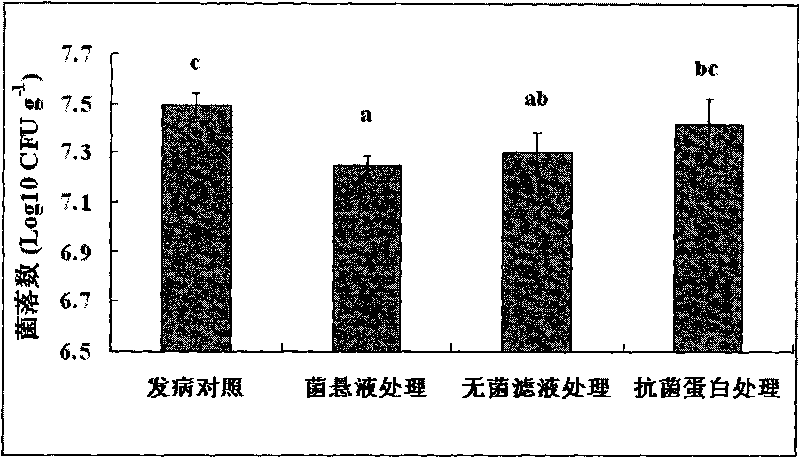Paenibacillus macerans for preventing and controlling plant bacterial wilt and application thereof
A technology of bacillus and hemp, which is applied in the field of Paenibacillus, can solve the problems of damage to the host vascular bundle conduction tissue, pathogenic bacteria are prone to drug resistance, and low resistance, and achieve the effect of preventing and treating plant bacterial wilt
- Summary
- Abstract
- Description
- Claims
- Application Information
AI Technical Summary
Problems solved by technology
Method used
Image
Examples
Embodiment 1
[0021] Example 1 Bacterial Strain Isolation and Purification
[0022] The surface soil of 0-20 cm around the cucumber rhizosphere was collected from a cucumber field where bacterial wilt occurred severely in Hangzhou City, Zhejiang Province, put into sterile polyethylene plastic bags, and sealed. Weigh 10g of soil, add it into a triangular flask with 90ml sterile water to prepare a suspension, shake it at 180r / min for 30min, then draw 5ml from the resulting suspension and add it to a triangular flask with 45ml sterile water, and gradually dilute to Until the 5th triangular flask, get 10 -1 、10 -2 、10 -3 、10 -4 and 10 -5 diluent.
[0023] Take 100μl 10 -4 and 10 -5 The diluted solution of smeared on nutrient agar medium (ie NA medium, containing: beef extract 1g, peptone 5g, yeast extract 5g, sodium chloride 5g, sucrose 10g, agar 20g, water 1000ml), each dilution Repeat 3 times, place in a 30°C constant temperature incubator and cultivate for 48 hours, pick a single col...
Embodiment 2
[0030] Example 2 strain identification
[0031] The main morphological and biological characteristics of the strains isolated above are as follows: the cells are rod-shaped, Gram-positive, and move with perinatal flagella. There are oval spores in enlarged cysts, and there is no soluble pigment on nutrient agar. Facultative anaerobic. The colony on the culture medium is thin, expanding in a star shape, with a large amount of bacteria and sticky, and the surface is dull. Growth will adhere to the medium. The optimum temperature for growth is 28-30°C, and the growth temperature range is 15-50°C. The optimum pH for growth is 7.0, and the growth pH range is 5.6-8.5.
[0032] The strain was identified as Paenibacillus macerans by FAME fatty acid analysis and named as Paenibacillus macerans ZJU0902.
Embodiment 3
[0033] Antagonistic activity of embodiment 3 bacterial strain ZJU0902 to Ralstonia solanacearum
[0034] In this example, the 8 R. solanacearum strains in Example 1 were still used as indicator strains. Add 1ml of the bacterial suspension of the indicated strain to 15ml of NA medium that has been sterilized and melted and cooled to about 45°C, shake well and pour the medium into a sterilized petri dish. Pick a single colony of Paenibacillus polymyxa ZJU0902 with a sterilized toothpick, and spot it on the medium with indicator bacteria. The culture condition is 30°C for 48 hours, and its antagonistic ability is determined according to the diameter of the inhibition zone. Antagonism results are as follows (Table 2):
[0035] Table 2 Antagonistic activity of Paenibacillus macerans ZJU0902 against Ralstonia solanacearum strains from different hosts
[0036]
[0037] The above results show that Paenibacillus macerans ZJU0902 has obvious antagonistic activity to other indicator...
PUM
| Property | Measurement | Unit |
|---|---|---|
| Diameter | aaaaa | aaaaa |
Abstract
Description
Claims
Application Information
 Login to View More
Login to View More - R&D
- Intellectual Property
- Life Sciences
- Materials
- Tech Scout
- Unparalleled Data Quality
- Higher Quality Content
- 60% Fewer Hallucinations
Browse by: Latest US Patents, China's latest patents, Technical Efficacy Thesaurus, Application Domain, Technology Topic, Popular Technical Reports.
© 2025 PatSnap. All rights reserved.Legal|Privacy policy|Modern Slavery Act Transparency Statement|Sitemap|About US| Contact US: help@patsnap.com



